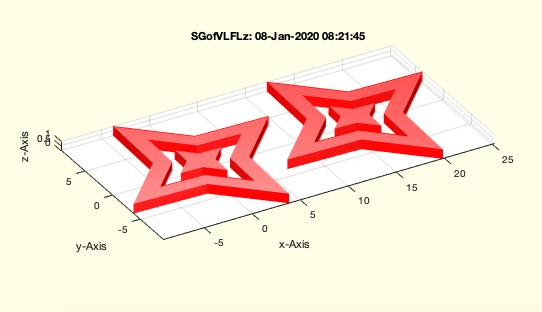SGofVLFLz
by Tim C. Lueth, SG-Lib Toolbox: SolidGeometry 5.6 - SG/Solids
Introduced first in SolidGeometry 4.9, Creation date: 2020-01-07, Last change: 2025-09-14
returns a fitting solid based on a surface, i.e. simplified version of SGofSurface
Description
Fast and stable function even for large data sets.
See Also: SGofSurface
, VLtransN
, VLFLvertexNormal
Example Illustration

Syntax
SG=SGofVLFLz(VL,FL,[z])
Input Parameter
VL: | | Vertex list of a surface (nx3) |
FL: | | Facet list of a surface (nx3) |
z: | | thickness of the solid; default is 0.5 |
Output Parameter
SG: | | resulting solid that can be attached to the surface |
Examples
[VL,FL]=VLFLsample(14); SGofVLFLz(VL,FL,1)
[VL,FL]=VLFLsample(18); SGofVLFLz(VL,FL,1)
Copyright 2020-2025 Tim C. Lueth. All rights reserved. The code is the property of Tim C. Lueth and may not be redistributed or modified without explicit written permission. This software may be used free of charge for academic research and teaching purposes only. Commercial use, redistribution, modification, or reverse engineering is strictly prohibited. Access to source code is restricted and granted only under specific agreements. For licensing inquiries or commercial use, please contact: Tim C. Lueth
Algorithm (Workflow)
This function, SGofVLFLz, is designed to create a solid geometry based on a given surface. It is a simplified version of the SGofSurface function.
Input Parameters
- VL: A vertex list of a surface, represented as an nx3 matrix, where n is the number of vertices.
- FL: A facet list of a surface, represented as an nx3 matrix, where n is the number of facets.
- z: The thickness of the solid. If not provided, the default value is 0.5.
Output
- SG: The resulting solid that can be attached to the surface.
Algorithm Steps
- The function begins by retrieving the thickness parameter
z using the getfuncparams function. If z is not provided, it defaults to 0.5.
- It then calls the
SGofSurface function with the parameters VL, FL, z, and additional fixed parameters (0, 0, true) to generate the solid geometry SG.
- If no output is requested (i.e.,
nargout==0), the function will:
- Invoke
SGfigure to create a new figure for visualization.
- Set the view angle to (-30, 30) using the
view function.
- Plot the solid geometry
SG with a red color and alpha transparency of 1 using SGplotalpha.
Example Usage
Two examples are provided to demonstrate the function:
[VL,FL]=VLFLsample(14); SGofVLFLz(VL,FL,1)
[VL,FL]=VLFLsample(18); SGofVLFLz(VL,FL,1)
These examples use the VLFLsample function to generate sample vertex and facet lists, and then create a solid with a thickness of 1.
Algorithm explaination created using ChatGPT on 2025-08-19 00:03. (Please note: No guarantee for the correctness of this explanation)
Last html export of this page out of FM database by TL: 2025-09-21